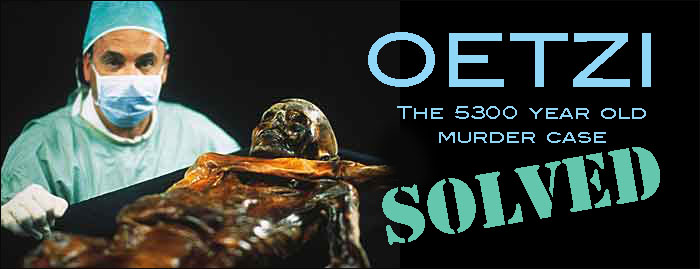 Oetzi: The 5000 Year Old Murder Case --SOLVED!
Oetzi the Iceman was found near Hauslabjoch in the Oetzal Alps on September 19, 1991, by Helmut and Erika Simon, two vacationing German hikers. Helmut was walking a bit ahead of his wife, when he spotted something. He thought it was some trash left by a careless hiker. But when he and his wife looked closer, they realized that they were looking at the body of a person, lying face down in some melting ice. Disturbed by their discovery, they assumed that they had found the mummified remains of an unfortunate mountain climber. Since it can be difficult to recover the body of a fallen climber, especially if a fresh snowfall covers the area, many people who have died in the mountains are often left there. Their body freezes and does not deteriorate; many such mummies have been recovered.
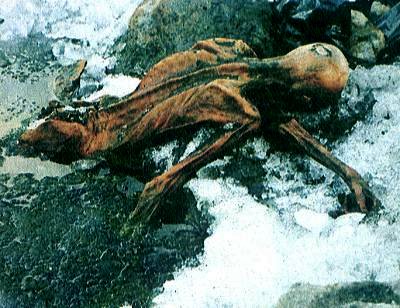 Helmut Simon wanted to take a photo, but his wife was appalled at the thought of taking a photo of a dead person. Still, Helmut managed to take one photo of the body (he had only two left photos on his roll of film). Then he got closer in order to inspect the body, which was in kind of gully. He saw an object or two around the body, but they meant nothing to him. The Simons weren't sure that they would report the body. They wondered if their vacation would be interrupted by completing police reports and other official requirements when a body is discovered. But after hike down the mountain for an hour, they stopped at a rustic lodge for something to drink. Only then did they decide to report their find to Markus Pirpamer, the caretaker of the lodge. In turn, he called the proper authorities who said they would recover the body the following day. The Simons, believing that they had discovered only a modern corpse, could not wait and continued down the mountain, heading for their hotel. Before they left, they provided Pirpamer with directions to the findspot. When the authorities arrived, they were well aware that the glacier had been melting. Three weeks earlier, the bodies of a man and woman who had gone hiking in 1934 and never returned had been discovered. For this reason, they, like the Simons, assumed that the person had died in a climbing accident. Mistakes Made... Ouch!
When he was finally freed, the Iceman was forced into a coffin, which caused his left arm to break. Then, when photographers were given time to take pictures of the mummy in a nearby morgue, a fungus began to spread across the Iceman's skin. In the end, Italian and Austrian authorities were shocked to discover that, rather than being a modern-day mountain climber, the man had died about 3000 B.C. He quickly came to be known as the Iceman, one of the oldest and best preserved human mummies ever found. Who was he? The body has been extensively examined, measured, x-rayed, and dated. Tissues and gut contents were examined microscopically, as was the pollen found on his gear. At the time of his death, Otzi was a 45 year old man, approximately 160 cm (5'3") tall. Analysis of pollen and dust grains and the isotopic composition of his teeth's enamel indicate that he spent his childhood near the present village of Feldthurns, north of Bolzano, but later went to live in valleys about 50 km further north. 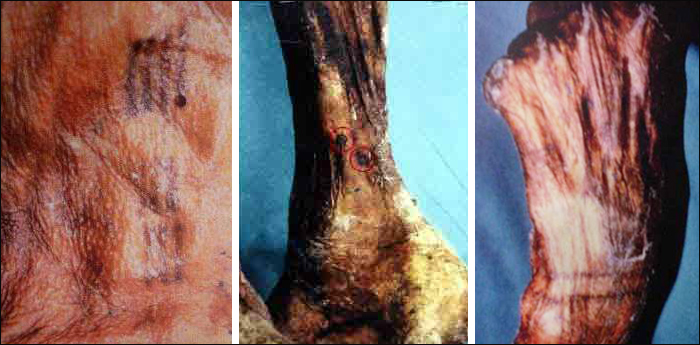
Initial tests puzzled scientists because they showed Oetzi was also sterile. The exact cause of this is still not known. The DNA within our cells contains the genetic information that spells out the "code of life." It is wound up in bundles known as chromosomes that are found in the cell nucleus (nuclear DNA); DNA also lies within mitochondria outside of the nucleus (mtDNA). mtDNA is inherited only through females via the egg and can be used to trace backwards through evolution; the male sex chromosome (Y) similarly tracks male evolution.
Dating on the material found with Oetzi put his death at about 5,300 years ago, during the Bronze Age. His death was the result of being shot in the back by an arrow, after which he almost certainly died quickly from loss of blood. Oetzi was in his 50's -- quite old for the time -- and his body showed a rough life. His hands clearly indicated he was involved in a fight earlier in the day and the angle of his fatal wound suggests he was shot from behind and at a low angle, as if ambushed while he tried to climb the mountains. A day in the life of Oetzi Several interesting tattoos were found on Oetzi's body. This suggests that, in his younger years, he may have belonged to a clan or family group and may have enjoyed a typical life, possibly even having a family. The fact that a man lived to his fifth decade is remarkable as the average life span for that time and region was almost half that age.  The stomach of Oetzi showed that he began his day with a meal in the wooded valley at the base of the Alps. This was proven by the pollen that was found in his stomach. He dressed himself for the cold and was found with the following items:
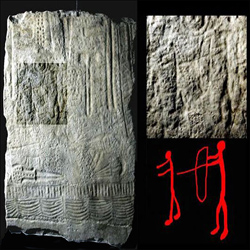 *A kind of goatskin poncho or coat *A bear fur cap tied with two leather straps *two goatskin leggings *a goatskin loincloth
The shoes were waterproof and wide, seemingly designed for walking across the snow; they were constructed using bearskin for the soles, deer hide for top panels, and a netting made of tree bark. Soft grass went around the foot and in the shoe and functioned like warm socks. The shoes have since been reproduced by experts and found to constitute such excellent footwear that there are plans for commercial production. *A woven grass mat. The mat, woven from swamp grass, was found in three separate pieces. At first, archaeologists believed that this was a cape, but the shoulders part of the cape seemed too narrow to be of any use. Instead, researchers now believe that this mat was worn over his head...as a type of protection from the rain (or possibly even snow). He also carried:
*A flint knife *An unfinished longbow made from yew that measured almost 6 feet, with a quiver full of arrows made with viburnum and dogwood shafts and flint heads *Among Otzi's possessions were two species of polypore mushrooms. One of these (the birch fungus) is known to have antibacterial properties, and was likely used for medical purposes. The other was a type of tinder fungus, included with part of what appeared to be a complex firestarting kit. The kit featured pieces of over a dozen different plants, in addition to flint and pyrite for creating sparks.
Blood and tissue on an arrowhead and axe were determined to be from several other individuals. There is also evidence that Oetzi was holding a knife when he emerged from the melting glacier. This suggests that he might have been attempting to escape just before he was fatally shot with an arrow at an altitude of 10,500 feet. His copper-headed axe and a quiver full of arrows were lying nearby. Official cause of death
Blood poured out into the surrounding tissue, forming a hematoma that can be seen in the breast cavity. "We can conclude that this was really a deadly hit from the arrowhead," said Dr. Frank Ruhli, University of Zurich. "He would not have walked around for days. It was a quick death.
Clotted blood also entered the hole caused by the arrow's wooden shaft, showing that it was broken off while Oetzi was still alive and therefore still bleeding. Dr Ruhli speculated that it was possible the Iceman removed the shaft himself. Alternatively, it could have been removed by an ally who tried in vain to help him, or perhaps by the attacker - if his arrows had a characteristic shaft - to try to cover up evidence linking him to the killing. Officially, Oetzi climbed up to the Schnalstal Glacier and died from cardiac arrest, brought on by shock, after sustaining massive blood loss. Oetzi represents one of the great archaeological finds of recent years. UPDATE: February 2009 Glacier man may have been attacked twice New investigations by an LMU research team working together with a Bolzano colleague reconstructed the chronology of the injuries that Oetzi, the glacier man found in Italy in 1991 and preserved as a frozen mummy, received in his last days. It turns out, for example, that he did in fact only survive the arrow wound in his back for a very short time - a few minutes to a number of hours, but no more - and also definitely received a blow to the back with a blunt object only shortly before his death. In contrast, the cut wound on his hand is some days older. "We are now able to make the first assertions as to the age and chronology of the injuries," reports Professor Andreas Nerlich, who led the study. "It is now clear that Oetzi endured at least two injuring events in his last days, which may imply two separate attacks." It is the oldest ice mummy ever found. Oetzi, the man from the Neolithic Age, is giving science critical information about life more than 5000 years ago, not least from his equipment. His copper axe, for example, reveals that metalworking was already much more advanced in that era than was previously assumed. Yet Oetzi's body, too, gives us many details as to his diet, state of health - and not least to his murder. "Some time ago, we detected a deep cut wound on Oetzi's hand that he must have survived for at least a couple of days," says Nerlich, head of the Institute of Pathology at Municipal Hospital Munich-Bogenhausen and member of the Medical Faculty of LMU. "Another team at about the same time found an arrow tip in Oetzi's left armpit. The shaft of the arrow was missing, but there is an entry wound on the back." It is probable, in that case, that the man died of internal bleeding because the arrow hit a main artery. What was unclear, however, was the age and exact chronology of the injuries. Now, Nerlich has reconstructed the missing chronology while working together with LMU forensic scientist Dr. Oliver Peschel and Dr. Eduard Egarter-Vigl, head of the Institute for Pathology in Bolzano. According to the new information, Oetzi did in fact only survive the arrow wound for a very short period of time, of no more than a few hours. A few centimeters below the entry wound they detected an additional small discoloration of the skin, which was probably caused by a blow from a blunt object. In both cases, the researchers managed to detect very briefly survived, yet unequivocally fatal bleeding. Above the spine are more discolorations that are not associated with bleeding. They probably occurred after the man's death, due to his interment, for example. "Oetzi had only shortly survived the arrow wound and the blow on the back," Nerlich summarizes. "At least a couple of days before his death, however, he sustained a severe cut wound on his right hand. Over several days, then, Oetzi suffered at least two injuring events - which could point towards two separate attacks." Sources: Ludwig Maximilian Universitat Munchen, The Earth Times (28 January 2009) UPDATE AUGUST 2010: Scientists decode Oetzi the Iceman's DNA A team of international scientists have decoded the DNA of the oldest mummified man ever found in an attempt to track down his relatives and map genetic changes over time. Nearly 20 years after Oetzi the iceman was found in a melting Alpine glacier on the border of Austria and Italy, researchers have extracted DNA from a bone in his pelvis and sequenced his entire genome. Oetzi died 5,300 years ago. His remains are now on display in a museum in the Italian town of Bolzano. Now Dr Albert Zink, the director of the Iceman Institute in Bolzano, said the information from Oetzi's DNA might shed light on hereditary aspects of diseases such as diabetes, hypertension and cancer. "There are key gene mutations that we know are associated with diseases such as cancer and diabetes and we want to see if Oetzi had them or whether they arose more recently," he said. Dr Zink now hopes to find Oetzi's living relatives in time for next year's 20th anniversary of his discovery. "From comparisons based on the mitochondrial DNA we weren't able to find any relatives in the region. But with the entire genome, there's a good chance we might," said Dr Zink. "We're at the start of a big and very exciting project. I think Oetzi is going to provide us with a lot of information." Oetzi was discovered in the snow on 19 September 1991. He was about 5ft 5in tall, weighed about 9.2 stone and was probably around 45 years old when he died. The trail of evidence provided in the NOVA episode of "The murder of the Ice Man" painted an entirely different picture for me. The confounding questions asked during the episode were: 1. Why did he have so many dysfunctional arrows? 2. Why did nobody take his valuable ax? Here is what I gathered from the show. The Ice Man was not the only person who died on that sight. There was a major battle and many dead people. The Ice Man was killed by an arrow and possibly a blow to the head. (Bleeding on the brain) The shaft of the arrow was pulled from his back leaving the arrow head stuck in his body. He also had a broken hand. The Ice Man was carrying so many dysfunctional arrows because he had performed the same ritual after shooting other people. He pulled the shafts and saved them for later repair. Putting on a new head would be easier than making a whole new arrow. Many valuable weapons are left on any field of battle. This ax was no different. The man who killed the Ice Man must have pulled his arrow shaft (and possibly clubbed him in the head) and went on fighting. The battle flowed away from the sight, possibly with large amounts of casualties. The battle may have happened in heavy snow fall, covering the dead and preventing later salvage. Nova pointed out that if the Ice man were fifty feet in any other direction that he would have been swept away in the glacier and ground to bits. The other bodies from the battle were swept away in the glaciers over the following thousands of years, leaving the Ice Man the sole surviving evidence of the 5000 year old battle sight. B.Petsal
Comments: With all the speculation about how he died, I find it strange that none of his attackers picked up his valuables. The copper axe would have been a real prize. So what is the explanation for all those valuable tools remaining with the body? Bob King | |

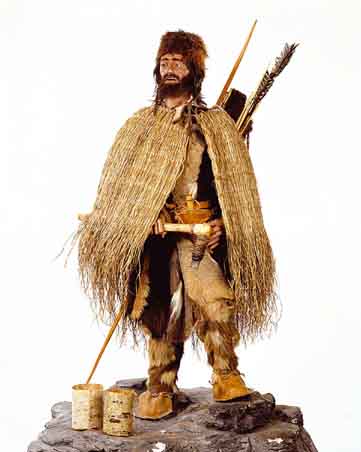 This explains why the Iceman's "rescuers" made quite a few careless mistakes: they weren't trying to preserve and protect the body, they were just trying to free it from the ice. At first, using a stick that they found nearby (later discovered to be his bow), they attempted to pry him free. They also tried to pull him from the ice by grabbing onto what was left of his clothing. In the process, they shredded it. One policeman was so anxious to free the mummy that he took a small jackhammer to the ice, accidentally drilling a hole in the Iceman's hip. And Pirpamer used an ice pick to finally extract the Iceman. (Brenda Fowler gives a thorough account of all the mistakes made in Iceman, Chapter 2.)
This explains why the Iceman's "rescuers" made quite a few careless mistakes: they weren't trying to preserve and protect the body, they were just trying to free it from the ice. At first, using a stick that they found nearby (later discovered to be his bow), they attempted to pry him free. They also tried to pull him from the ice by grabbing onto what was left of his clothing. In the process, they shredded it. One policeman was so anxious to free the mummy that he took a small jackhammer to the ice, accidentally drilling a hole in the Iceman's hip. And Pirpamer used an ice pick to finally extract the Iceman. (Brenda Fowler gives a thorough account of all the mistakes made in Iceman, Chapter 2.)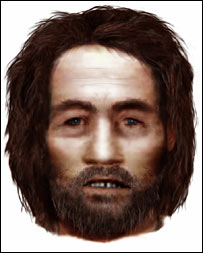 He had 57 tattoos [above], some of which were located on or near acupuncture points that coincide with the modern points that would be used to treat symptoms of diseases that Otzi seems to have suffered from, such as digestive parasites (whipworm, which causes weight loss) and osteoarthrosis. Some scientists believe that these tattoos indicate an early type of acupuncture.
He had 57 tattoos [above], some of which were located on or near acupuncture points that coincide with the modern points that would be used to treat symptoms of diseases that Otzi seems to have suffered from, such as digestive parasites (whipworm, which causes weight loss) and osteoarthrosis. Some scientists believe that these tattoos indicate an early type of acupuncture. Published in this month's issue of Current Biology, the research has generated the oldest complete Homo sapiens mtDNA genome to date, and overturns previous research conducted in 1994 on a small section of Oetzi's mtDNA, which suggested that relatives of Oetzi may still exist in Europe.
Published in this month's issue of Current Biology, the research has generated the oldest complete Homo sapiens mtDNA genome to date, and overturns previous research conducted in 1994 on a small section of Oetzi's mtDNA, which suggested that relatives of Oetzi may still exist in Europe.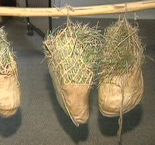 *Two shoes. When he was discovered, the Iceman was wearing only his right shoe. They were made of various animal skins: bearskin soles, deerskin insteps, and chamois/cow/calf/lindenbark uppers. The uppers were worn with fur on the outside and laced up. Dried tree bark (lime bast) was also stuffed inside the shoes to keep his feet warm. Although these are the oldest "shoes" ever found, a pair of 10,000-year-old slippers was discovered in Oregon.
*Two shoes. When he was discovered, the Iceman was wearing only his right shoe. They were made of various animal skins: bearskin soles, deerskin insteps, and chamois/cow/calf/lindenbark uppers. The uppers were worn with fur on the outside and laced up. Dried tree bark (lime bast) was also stuffed inside the shoes to keep his feet warm. Although these are the oldest "shoes" ever found, a pair of 10,000-year-old slippers was discovered in Oregon.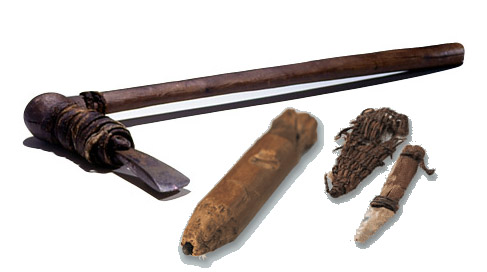 *A copper axe with a yew handle
*A copper axe with a yew handle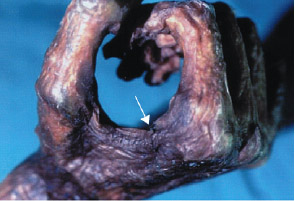 At some time during his last day of life, Oetzi was involved in a ferocious battle. Tests on the body revealed a deep wound on Oetzi's right hand and wrist which, according to the findings, were inflicted in the last few hours of the iceman's life. These wounds appear to be defensive in nature.
At some time during his last day of life, Oetzi was involved in a ferocious battle. Tests on the body revealed a deep wound on Oetzi's right hand and wrist which, according to the findings, were inflicted in the last few hours of the iceman's life. These wounds appear to be defensive in nature. 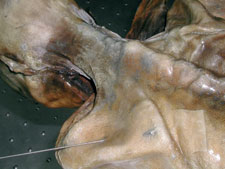 Recent advances in computerised tomography (CT), a sophisticated X-ray scan that allows multidimensional imaging, have given researchers an unprecedented view of Oetzi's internal anatomy. The pictures reveal a 13mm-long rip in Oetzi's left subclavian artery which lies just under the collar bone.
Recent advances in computerised tomography (CT), a sophisticated X-ray scan that allows multidimensional imaging, have given researchers an unprecedented view of Oetzi's internal anatomy. The pictures reveal a 13mm-long rip in Oetzi's left subclavian artery which lies just under the collar bone.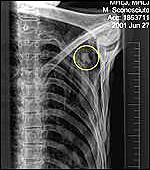 "Theoretically, you could have been hit by an arrow and survive. If it doesn't hit an artery or the lung, and you don't get an infection it shouldn't be a problem."
"Theoretically, you could have been hit by an arrow and survive. If it doesn't hit an artery or the lung, and you don't get an infection it shouldn't be a problem."